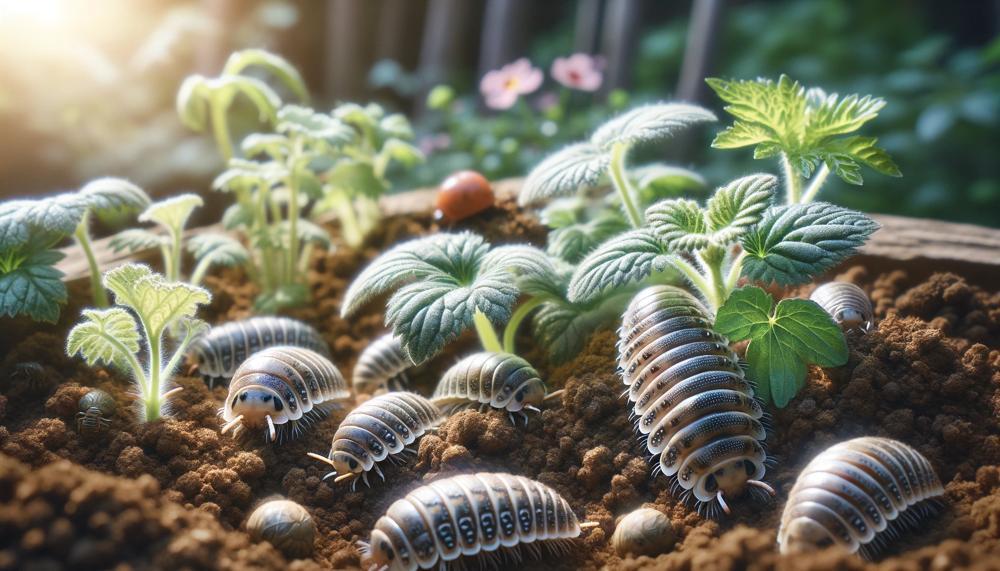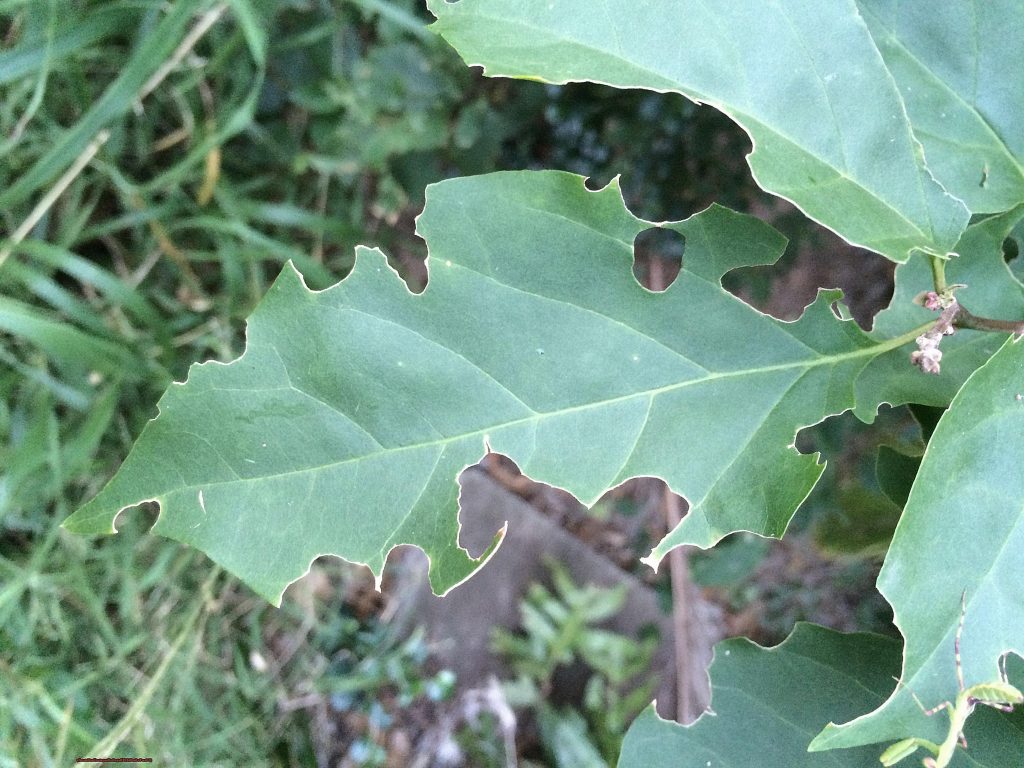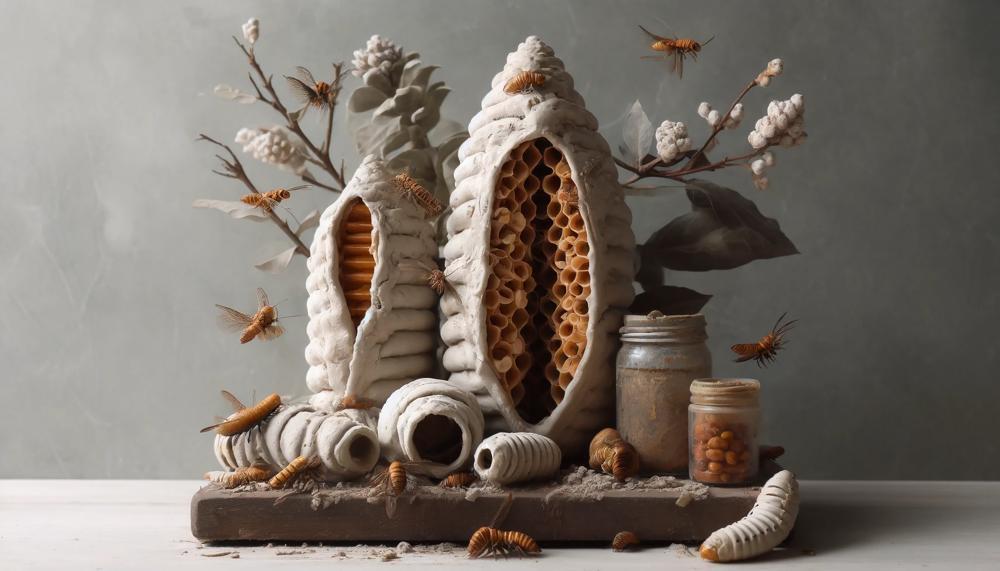There are some ways to get rid of pill bugs in your garden:
- Reduce moisture: Pill bugs like moist soil, so you can try removing dead plant matter and avoiding overwatering. You can also improve air circulation around your plants by trellising vines.
- Use diatomaceous earth: This powder is made from crushed shells and acts as a natural drying agent that removes moisture pill bugs need. You can sprinkle it on wet areas to absorb moisture and kill pill bugs.
- Use beer: Dig a shallow hole in the soil and fill it with beer to attract the pill bugs, who will drown. You’ll need to empty and refill the traps regularly.
- Use coffee grounds: Sprinkle coffee grounds around the base of the plant to repel the pill bugs with the caffeine. Coffee grounds can also provide nutrients to your plants.
- Use insecticides: You can use insect killer granules and botanical insecticides. For example, Sluggo Plus is an organic pesticide that poisons a wide variety of insects but is safe for birds and other wildlife.
You can also trap and relocate pill bugs by providing a moist, sheltered place for them, such as a pile of dead leaves. Then, scoop up the leaves and bugs and place them in your compost bin.
So, let’s start.
Table of Contents
- 1 Best Natural Pill Bug Control Methods For the Home Gardener
- 2 Don’t give rollie pollies in the garden what they want
- 3 Set traps to get rid of rollie pollies in your garden
- 4 Make paper tube, newspaper, or duct tape collars how to get rid of rollie pollies in your garden
- 5 Overplant to overwhelm the rollie pollies in the garden
- 6 Use Diatomaceous earth (DE) or Nematodes to combat pill bugs in the home garden
- 7 Which natural pill bug control methods should you try in your home garden?
- 8 If this post about natural pill bug control methods was helpful, please share it:
- 9 Conclusion
Best Natural Pill Bug Control Methods For the Home Gardener
| Method | Description | How to Apply |
| Environmental Adjustment | Reduce moisture and remove decaying plant matter to make the environment less appealing to pill bugs. | Water gardens in the morning and clear away any dead leaves or plant debris regularly. |
| Physical Barriers | Diatomaceous earth or crushed eggshells can deter pill bugs from reaching plants. | Encircle vulnerable plants with a barrier of diatomaceous earth or finely crushed eggshells. |
| Predatory Assistance | Introduce natural predators like ground beetles or specific nematodes to control pill bug populations. | Add beneficial nematodes to the soil or encourage ground beetle habitats by providing shelter such as stones or wood logs. |
| Manual Removal | Physically removing pill bugs from the garden area. | Regularly inspect plants, especially under leaves and near the soil, and remove any pill bugs found by hand. |
| Natural Repellents | Utilise essential oils as a natural deterrent for pill bugs. | Spray a mixture of water and essential oils (like peppermint or neem oil) around the base of plants. |
| Trapping | Create traps using fruit or beer to attract and then drown pill bugs. | Place containers filled with beer or pieces of fruit in strategic locations around the garden overnight. Empty and refill as needed. |
| Protective Wrapping | Shield seedlings from pill bug damage with physical barriers. | Wrap the stems of young plants with duct tape (sticky side out) or newspaper to prevent access by pill bugs. |
| Overplanting Strategy | Sow more seeds than necessary anticipating some loss to pests like pill bugs. | Plant extra seeds alongside your main crops as a sacrificial buffer, ensuring some survive despite pest activity. |

By incorporating these strategies, home gardeners can effectively control pill bug populations in a natural and eco-friendly manner.
Mixing and matching these methods based on specific garden conditions and pest pressures may offer the best results.
Don’t give rollie pollies in the garden what they want
To thwart rollie pollies, those uninvited guests in your garden, from thriving and wreaking havoc among your beloved plants, a multi-faceted approach is the key.
Here’s how you can create a less inviting environment for these critters and safeguard your garden without resorting to harsh chemicals.
Eliminate their Favorites
Rollie pollies feast on decaying organic matter, so keeping your garden tidy is step one. Remove wet leaves, fallen fruit, and dead plant debris promptly.
This not only deprives them of their food source but also reduces the moist conditions they adore.
Defensive Gardening Tactics
| Strategy | Description | Benefit |
| Protective Wrapping | Wrap seedling stems in duct tape or newspaper. | Creates a barrier against pill bug damage. |
| Overplanting and Thinning | Sow extra seeds and thin out excess seedlings later. | Ensures survival of sufficient plants even if some are damaged. |
| Diatomaceous Earth (DE) | Apply around plants; it dehydrates pill bugs on contact. | A natural and safe method for controlling pill bug numbers. |
| Natural Predators | Introduce nematodes (Steinernema carpocapsae) into the soil. | Targets and reduces pill bug populations effectively. |
Trapping as a Tactic
Setting up traps can be an effective way to catch and remove pill bugs from your garden. Use hollowed-out fruit or containers filled with beer or yeast mixture to lure them in.
Check these traps regularly, disposing of any caught pill bugs far from your garden.
Environmental Adjustments
Maintaining a dry surface soil layer by watering in the morning helps reduce moisture levels by evening, making it less hospitable for rollie pollies.
Ensure good drainage throughout your garden and consider using raised beds to further discourage their presence.
By integrating these strategies, you’re not just telling rollie pollies they’re unwelcome; you’re actively creating an environment that discourages their settlement and protects your garden. Remember, persistence is key—regularly inspect your garden for signs of pill bug activity and adjust your tactics as needed.
Set traps to get rid of rollie pollies in your garden
To effectively set traps and bid farewell to rollie pollies in your garden without resorting to harsh chemicals, a bit of ingenuity and understanding of their preferences go a long way.
Creating the Perfect Trap:
Fruit Traps
Rollie pollies can’t resist the sweet scent of overripe fruit. You can use this to your advantage by setting up a fruit trap.
- Method: Place pieces of overripe fruits, such as melon, banana, or strawberries, in shallow dishes or directly on the soil in your garden during the evening.
- Action: The rollie pollies will be attracted to the fruit overnight. In the morning, you can collect and dispose of the critters.
- Frequency: Repeat nightly until you notice a significant decrease in their population.
Beer Traps
Surprisingly, rollie pollies are also attracted to beer, making it an effective lure.
- Method: Dig small holes in your garden and place shallow containers (such as tuna cans) level with the soil surface. Fill these containers with beer.
- Action: The scent of beer draws the rollie pollies into the container, where they fall in and cannot escape.
- Frequency: Check and empty the traps every morning, refilling with fresh beer as needed.
Protective Measures:
While traps reduce the population, protecting your seedlings from any remaining rollie pollies ensures your garden thrives.
| Method | Application | Effectiveness |
| Duct Tape | Wrap the stems of seedlings with sticky duct tape (sticky side out). | Prevents rollie pollies from climbing and damaging young plants. |
| Diatomaceous Earth (DE) | Spread a barrier of DE around susceptible plants. | Dehydrates and kills rollie pollies on contact without harming plants. |
| Nematodes (Steinernema carpocapsae) | Apply nematodes to moist soil early morning or late afternoon. | Targets and kills rollie pollies at their source in the soil. |
Combining Forces:
For a truly rollie-pollie-free garden, combine trapping with these protective measures. It’s akin to setting up a defence line while actively removing invaders.
Make paper tube, newspaper, or duct tape collars how to get rid of rollie pollies in your garden
To effectively rid your garden of rollie pollies using paper tube, newspaper, and duct tape collars, follow these detailed steps. This method combines simplicity with efficacy, keeping your garden’s ambiance naturally balanced.
| Material | Steps | Tips |
|---|---|---|
| Paper Tube (Toilet Paper Roll) | Collect empty toilet paper rolls. Make a single cut from one end to the other. Gently open and place the roll around the stem of the plant, ensuring it’s snug. Push the roll slightly into the soil to secure it. |
Ensure the tube is snug around the stem but not tight enough to constrict plant growth. This prevents rollie pollies from climbing over. |
| Newspaper Collar | Tear strips of newspaper approximately 4 inches wide. Wrap a strip gently around the stem of each seedling, forming a collar that extends a few inches above and below soil level. Bury the lower part of the strip into the soil to secure it. |
Multiple layers can be more effective in deterring rollie pollies. The newspaper will gradually decompose but should last long enough to protect young plants. |
| Duct Tape Collar | Cut a piece of duct tape long enough to circle the plant stem with an extra inch for overlap. Wrap the tape around the base of the stem, sticky side out, making sure it’s not too tight. Press firmly on the overlap to secure. |
The sticky surface of the duct tape faces out to catch rollie pollies attempting to climb up. Check and replace as needed due to dust or debris reducing stickiness. |
Combining these methods with diligent garden hygiene, such as removing excess moisture and organic debris, significantly reduces rollie pollie populations.
Remember, while these critters can be a nuisance, they also play a role in breaking down organic matter, so aim for balance rather than eradication.
Overplant to overwhelm the rollie pollies in the garden
Overplanting serves as a strategic maneuver in the garden to counteract the voracious appetites of rollie pollies, or pill bugs, ensuring that your green space thrives despite their presence.
By planting more seeds than you need, you essentially play the numbers game against these critters, increasing the likelihood of seedling survival and eventual harvest success.
- Increased Odds of Seedling Survival: Pill bugs are known for nibbling on young, tender plants. By sowing more seeds, you create a buffer zone for your garden. Even if some seedlings fall victim to these bugs, others will survive and flourish.
- Distracts Pests from Target Plants: With more plants around, pill bugs are less likely to concentrate on any single seedling. This dispersion of their attention can safeguard more vulnerable plants and reduce overall damage.
- Creates a More Robust Garden Ecosystem: Overplanting encourages biodiversity in your garden, which can attract beneficial insects that prey on pill bugs and other pests. This natural pest control method reduces your reliance on chemical interventions.
To illustrate the effectiveness of overplanting as a strategy against pill bugs, consider the following table:
| Strategy | Benefits | Potential Outcome |
| Overplanting | Increases seedling survival rates | A lush, thriving garden with reduced pill bug damage |
| Diversification of plant types | Attracts beneficial predators; reduces pest concentration | A balanced ecosystem with natural pest control mechanisms |
| Regular monitoring and maintenance | Early detection of pest issues; opportunity for targeted intervention | A healthier garden with minimal pest impact |
It’s clear that incorporating overplanting into your gardening strategy not only mitigates the threat posed by pill bugs but also enriches your garden’s health and diversity.
Remember, combining overplanting with other organic methods, such as using diatomaceous earth or nematodes and removing excess moisture, can further enhance your defense against these common garden pests.
Use Diatomaceous earth (DE) or Nematodes to combat pill bugs in the home garden
Diatomaceous Earth (DE) and Nematodes are two natural, efficient foes of the common garden pest, the pill bug. Known for their destructiveness in gardens, pill bugs can be a real headache for green thumbs. But fret not, for DE and Nematodes come to the rescue in a manner that’s safe for your garden’s ecosystem.
Diatomaceous Earth (DE):
DE is akin to nature’s own pest controller. This fine powder is made from the fossilized remains of tiny, aquatic organisms called diatoms. Under a microscope, DE looks like a collection of glass shards.
When pests like pill bugs come into contact with DE, it messily disrupts their waxy outer layers and leads them to dehydrate and die.
Nematodes:
Nematodes are microscopic, worm-like organisms that are natural parasites to garden pests, including pill bugs. These tiny warriors invade the bodies of pill bugs, releasing bacteria that ultimately kill their hosts.
The beauty of nematodes lies in their specificity; they target pests without harming beneficial insects or the garden’s overall health.
| Aspect | Diatomaceous Earth (DE) | Nematodes |
| Function | Works by causing physical damage to pests through dehydration. | Biological control that uses bacteria to kill pests from the inside. |
| Safety | Safe around children and pets when using food-grade DE. | Harmless to humans, pets, and beneficial garden inhabitants. |
| Application | Applied as a powder to affected areas or plants. | Introduced to soil or plants in liquid form. |
| Effectiveness | Effective against a wide range of pests but must be reapplied after rain. | Targets specific pests and can offer long-term control in suitable conditions. |
Both DE and nematodes offer compelling benefits in the battle against pill bugs. DE acts swiftly by physically damaging the pests, while nematodes provide a strategic biological attack. For gardeners seeking an eco-friendly solution, combining these two methods can ensure your green sanctuary remains both lush and pest-free.
To maximize effectiveness, remember to apply DE during dry weather and introduce nematodes during cooler parts of the day, ideally in moist soil conditions.
Which natural pill bug control methods should you try in your home garden?
To keep those cheeky pill bugs at bay in your home garden, a blend of cunning tactics and natural remedies does the trick. Here’s how you can declare war on them, without harming the planet or your precious plants.
| Method | Description | How to Apply |
| Adjust Your Watering Schedule | Limit moisture as pill bugs thrive in damp environments. | Water your garden in the morning so it dries by evening. |
| Create Physical Barriers | Diatomaceous earth or crushed eggshells deter pill bugs with their sharp edges. | Encircle susceptible plants with a barrier of your choice. |
| Welcome Predatory Allies | Invite natural predators like ground beetles or introduce beneficial nematodes. | Maintain a diverse garden to attract beetles or apply nematodes directly to the soil. |
| Manual Removal | Pick off pill bugs when you see them as a direct control method. | Do regular inspections, especially under pots and decaying matter. |
| Natural Repellents | Essential oils such as peppermint act as a deterrent. | Mix with water and spray lightly around affected areas. |
Remember, the trick isn’t just about attacking them head-on; it’s about making your garden a fortress they’d rather avoid. Keep it tidy by removing plant debris where they hide and breed. Also, ensure proper drainage because soggy gardens are pill bug paradises.
Absolutely, this post on natural pill bug control methods is a gem worth sharing.
If you’ve been at your wit’s end, trying to keep these little armoured critters at bay without resorting to harsh chemicals, the solutions detailed here are both effective and kind to Mother Earth.
| Method | Action | Benefit |
| Adjust Watering | Reduce moisture | Lowers pill bug appeal |
| Physical Barriers | Duct tape/newspaper collars | Protects seedlings directly |
| Predatory Allies | Encourage birds/insects | Natural pest control |
| Manual Removal | Hand-picking | Immediate reduction |
| Natural Repellents | Diatomaceous earth/nematodes | Safe for garden ecosystem |
Sharing this post with friends, family, or any gardening group you’re part of isn’t just about spreading wisdom; it’s about fostering a community that values sustainable practices.
So, yes, if you found solace in these words and success in these methods, pass it on.
Conclusion
Accepting the abundance of nature, the piece reveals a mosaic of tactics to beat pill bugs in the garden, demonstrating the coexistence of human resourcefulness and the natural equilibrium of our parks. It is a story of defense that uses the soft touch of natural treatments found on Earth rather than the harshness of pharmaceuticals. Tales of environmental modification, such as removing their beloved moisture and organic food, are used to tell the story of battling these tiny armored invaders.
Earth’s minerals and the common eggshell, a symbol of nature’s tenacity, fortify the physical barriers that protect our garden. We call on the brave guardians of the garden, from the elusive ground beetle to the little might of helpful nematodes, all of whom contribute to this vast ecosystem. Natural repellents whisper stories of old, scented defenses, while the hands-on technique of manual removal reconnects us with the land.
The clever use of traps, which turns the pill bugs’ own wants against them, and protective collars made of paper and tape, which armour our young plant fighters, further widen the approach. Furthermore, in the attitude of plenty, overplanting turns into a gracious act of resistance that ensures the survival of many.
The protagonists of this story are diatomaceous earth and nematodes, whose strategies resemble the complex dance of life and death in the garden’s underbrush. This piece is not just a manual; it is a rallying cry for gardeners to take on the role of custodians of their own green spaces, using the tools the land has given them to preserve harmony and safeguard the abundance of greenery gifted to us.





